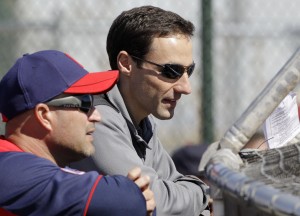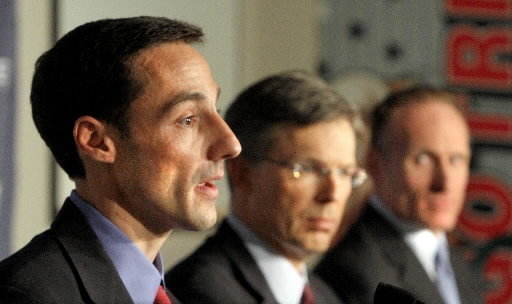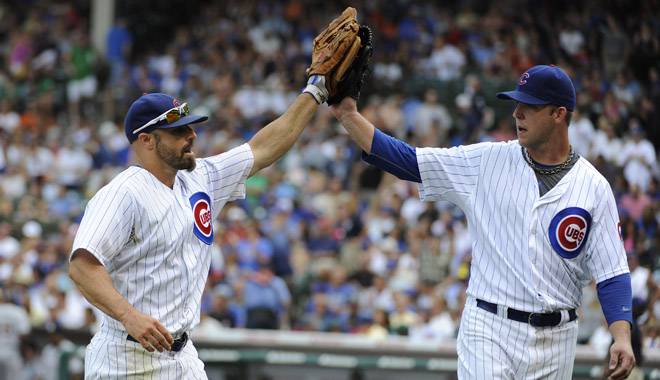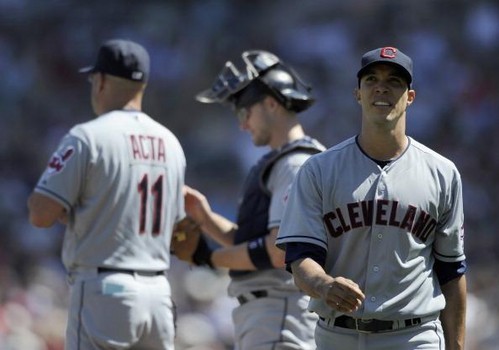 Indians Archive
Indians Archive  Tomahawks Cutting Through the Gossamer
Tomahawks Cutting Through the Gossamer
 The Trading Deadline (the first one at least) has come and gone and the Indians’ roster on Tuesday night looks like the Indians’ roster of Monday night and while the rumors flew as sports-talk radio (and much of the silk of the Interwebs) spewed nonsense and vitriol, the Indians were ultimately neither buyers or sellers. So while the gossamer (fancy name for spider silk) flew the last couple of days regarding whether Choo would still be an Indian or if Masterson was really on the block (with Castrovince nailing the schizophrenic frenzy of this time of year), I often remember what the editor of “The New Yorker” said to Elaine Benes – in a classic episode of “Seinfeld”, when asked to explain a particularly vexing cartoon from his magazine – when he said, “one doesn’t dissect gossamer”.
The Trading Deadline (the first one at least) has come and gone and the Indians’ roster on Tuesday night looks like the Indians’ roster of Monday night and while the rumors flew as sports-talk radio (and much of the silk of the Interwebs) spewed nonsense and vitriol, the Indians were ultimately neither buyers or sellers. So while the gossamer (fancy name for spider silk) flew the last couple of days regarding whether Choo would still be an Indian or if Masterson was really on the block (with Castrovince nailing the schizophrenic frenzy of this time of year), I often remember what the editor of “The New Yorker” said to Elaine Benes – in a classic episode of “Seinfeld”, when asked to explain a particularly vexing cartoon from his magazine – when he said, “one doesn’t dissect gossamer”.
But that’s exactly what we do – dissect “gossamer” – for the course of days, weeks, and (now seemingly) months as the MLB Trading Deadline has somehow become the pre-packaged equivalent of the NFL Draft, where very sharp lines are drawn as to what an organization is doing (or not doing) on a random day at the end of July, with a little less than 40% of the season still in front of us? We take these “whispers” from sources and track all of the movement (or non-movement) on the “bottom line” because a 4-letter word that emanates from Bristol tells baseball fans that THIS is the most important day of the baseball season…you know, just like the NFL Draft has grown from a cottage industry into a year-round corporation.
Could the Tribe have gotten this guy…
What were the packages offered for that guy…
Were some of the Tribe veterans on the Trade Block…
What exactly are they doing down there…
And when the Trading Deadline passes, “winners” and “losers” are immediately pointed to and teams are criticized for sitting on their hands or are lauded for their aggressiveness, we all know (all too sharply, after the Ubaldo trade last year) that the games are played on the field and not in the “Transactions” page in late July.
So while that answer from the editor of “The New Yorker” that “one doesn’t dissect gossamer” was as infuriatingly incomplete to Elaine as it is to all of us today as we sit wondering where this organization thinks it is heading and what kind of “window of contention” we’re actually talking about, let’s attempt to make some sense of the last couple of days. Because as much fun as it is to guess and play these games about which player would look good in a Tribe uniform or as horrifying as it is to think about the day when Choo moves on from Cleveland – and I think that’s coming this Winter – at the end of the day, the Indians are sitting essentially where they were prior to the Deadline.
Yes, they picked up Lars Anderson from Boston for Akron knuckleballer (and my TCF colleague Brian McPeek had a great line about how the move would immediately spun by some as trading the “next RA Dickey” for the “next Matt LaPorta”…which it has been), but it’s a move that I don’t have much of an issue with. Unless you think that LaPorta/Canzler/Weglarz are more than Minor-League fodder, Anderson (who, it should be noted is 3 years younger than LaPorta and Canzler) represents a potential option at 1B past 2012. Don’t take that to mean that I think that Lars Anderson is the answer the way that LaPorta (who was the same age as Anderson when he was acquired by the Tribe, with Anderson already having spent some time in AAA and MLB) was once thought to be, but it’s a low-risk move that could benefit Anderson and the Tribe.
Certainly, most fans wanted more than a “low-risk move” and wanted a grand pronouncement of which direction the Indians’ organization were heading on a random afternoon in late July, but I think it’s been articulated in this space pretty well for the past couple of weeks that the Indians’ offense is young and full of promise and potential and that the pitching is what was needed – for longer than just a couple of months – with the Indians lacking the ammo (in terms of prospects) to make an impact move.
That’s not to say that I think that there were missed opportunities, because I’ll get to that, as soon as I get some of these Tomahawks in the air…
__________
While not specifically related to the Indians, there were some really interesting pieces from Baseball Prospectus this past week (and I’ll plug spending any $ that you pay to ESPN and re-directing to B-Pro if you’re a baseball fan that enjoys “steak” more than “sizzle”) and the most interesting article came from Dan Evans, a former MLB GM, who provides an inside look at the week or so leading up to the Trade Deadline.
The whole thing is unquestionably worth a read, but this is what I found to be the most pertinent part as it relates to what we saw happen with the Tribe from last Friday through 4 PM on Tuesday:
 In many organizations, deciding where the team stands at the deadline is the most difficult part of the process. There are 17 teams within five games of a playoff berth today, and herein lies the tough call. Are we a buyer or a seller? This conversation isn't comfortable, as it requires a sit-down with ownership about where you are as a franchise. This is a critical phase, since you need to come clean and then find out what direction ownership wants to take. If you are the general manager, it also is a job review of sorts, since your work is under inspection. This chat requires some preparation, because you have to go into the meeting with a plan. For some GMs in fragile stages of their contracts, it can be the beginning of the end of their employment.
In many organizations, deciding where the team stands at the deadline is the most difficult part of the process. There are 17 teams within five games of a playoff berth today, and herein lies the tough call. Are we a buyer or a seller? This conversation isn't comfortable, as it requires a sit-down with ownership about where you are as a franchise. This is a critical phase, since you need to come clean and then find out what direction ownership wants to take. If you are the general manager, it also is a job review of sorts, since your work is under inspection. This chat requires some preparation, because you have to go into the meeting with a plan. For some GMs in fragile stages of their contracts, it can be the beginning of the end of their employment.
Everyone likes to talk about what you're looking to add as a contender, but the other path is the much more difficult one. If you are one of the 13 or so clubs who woke up today with little or no chance to play in the postseason, you have to evaluate who is part of your nucleus for the following year and beyond and whom you might consider moving to try to contend in the future. This is where your scouts and minor-league staff become critical decision makers if you're doing it right. If they can evaluate well and are realistic about your personnel, you can make shrewd moves. If not, two years later you'll still be waiting for guys to get out of Double-A. It is extremely tough to communicate with your staff if you are going to change course, but if there is a distinct plan, they will be part of the solution, not the problem.
Evans gets a little into the difficulty in adding a pitcher around this time – which I think is VERY relevant, particularly when you look at what it took to net some of these arms on the trade market – but I think that this Trading Deadline forced the Indians to ask some very difficult questions about their own players and where they stand as an organization. It’s been well-documented (here and elsewhere) that the Ubaldo deal signaled – or at least was supposed to signal – the “opening” of this “window of contention”, but the Indians have muddled around the .500 mark since that trade and to look at their “window” leads us to another great piece from B-Pro about the A’s – who traded away Gio Gonzalez in the off-season – and how they’re suddenly staring into a window of contention, and what these “windows” exactly mean, particularly to small-market teams like the Tribe and the A’s.
Contained within THAT piece is a link to a seminal article written by Nate Silver (some 6+ years ago) on how teams should approach the Trading Deadline, dividing them into “categories” based on the likelihood/unlikelihood of making the playoffs and the coming years. In part, his definitions of those “categories” are what makes the piece so intriguing for the Tribe…and remember this was written after the 2005 season:
Category I. Rebuilding: 82 projected wins or fewer.
Optimal Strategy: Sell
Ordinarily, the teams in this group will be happy to trade what veteran talent they have if they can get favorable prospects or cash flow in return; a playoff appearance is just too unlikely.
However, the clubs toward the right-hand edge of Category I might consider becoming buyers if at least a couple of the following circumstances coalesce:
- The team has a handful of good young players who might be capable of a breakout season;
- The team plays in a weak division;
- It looks to be a good buyers' market;
- The team can build without compromising its future--that is, without trading good prospects, and without making long-term contract commitments to veterans.
- There are external, economic factors that would tend to reward aggressive behavior, such as the negotiation of a TV contract or stadium deal.
A team like last year's Indians, for example, merited an exception to the rule. The Indians were a young club playing in what looked to be a weak division, and weren't too far from Category II status, coming off an 80-win season. They were able to sign Kevin Millwood to a reasonable, one-year contract. It almost worked, but they still missed the playoffs by two games, and finished third from the bottom in American League attendance. Over the long run, this strategy is going to miss a lot more often than it hits.
--snip--
Category II. Fringe Contender: 82-87 projected wins.
Optimal Strategy: Buy or Sell
Teams in this group have a natural tendency to stand pat. The thinking seems to be: we're fielding a reasonable baseball club, and we think we can contend with a couple of good breaks. Look what happened to the White Sox last year. We certainly aren't about to break the bank.
In fact, however, standing pat is the worst alternative for these clubs. Whether to buy or sell is conditioned on some of the same factors that we've described above, but either strategy is superior to holding. Buying is likely to produce a reasonably good return; although a team with 85-win talent will make the playoffs occasionally, a team with 90-win talent will make the playoffs more often than not. On the other hand, if buying isn't feasible, then selling needs to be considered. Going from 85 wins to 80 doesn't hurt as much as going from 85 to 90 helps, and there is nothing worse for a baseball team than to be caught in the 84-78 netherworld.
This is fascinating stuff to think about in the context of where the Indians sit right now and while Silver wrote the piece as it pertains to decisions to be made in July, I think that the performance of this club down the stretch – and particularly Masterson and Ubaldo – are going to force some very difficult decisions about which “category” the Indians fall into this off-season even more so than in the past week. While arguments were made over the last couple of days to clear the decks (and some of the “arguments” were pretty compelling), to see the Indians send out feelers on Choo, Perez, and even Masterson leads me to believe that they’re gauging the market for each with the idea that one or two (I don’t think all three) could be moved in the off-season as the Indians attempt to load up with an eye towards 2013.
Then again, we all thought that eye was focused on 2012 when the Ubaldo deal was made this time last year…
__________
While the Indians essentially decided to stand pat – or at least put off a large organizational decision until the off-season – that doesn’t mean that there weren’t some deals that were consummated over the course of the last week that didn’t raise some eyebrows in terms of players that the Indians had (or at least should have) targeted and what kind of package it took to pry those players loose.
 Most notable was the trade between the Cubs and the Braves that sent LHP Paul Maholm (under club control through next year) and 4th OF/LHP masher Reed Johnson to Atlanta, as those two players would have filled the Indians’ needs – short-term and long-term – pretty neatly by adding to the rotation for today and tomorrow and by upgrading from the troika currently roaming around LF. And while the cost for the Braves looks like a couple of Minor-League arms (and one injured one at that), let’s realize that Atlanta gave up a 21-year-old RHPin Aroldys Vizcaino that throws in the upper-90s that ranked #62 on Kevin Goldstein’s pre-2011 prospect list who had already made it to MLB as a 20-year-old last year. Though Vizcaino may end up in the bullpen and while I realize that he’s been hurt and doesn’t figure to contribute until next year…yeah, that young, fireballing arm is still something that the Indians don’t have unless you’re talking about them giving up a Carlos Carrasco (who is 4 years older than Vizcaino and not under club control for as long) for that duo.
Most notable was the trade between the Cubs and the Braves that sent LHP Paul Maholm (under club control through next year) and 4th OF/LHP masher Reed Johnson to Atlanta, as those two players would have filled the Indians’ needs – short-term and long-term – pretty neatly by adding to the rotation for today and tomorrow and by upgrading from the troika currently roaming around LF. And while the cost for the Braves looks like a couple of Minor-League arms (and one injured one at that), let’s realize that Atlanta gave up a 21-year-old RHPin Aroldys Vizcaino that throws in the upper-90s that ranked #62 on Kevin Goldstein’s pre-2011 prospect list who had already made it to MLB as a 20-year-old last year. Though Vizcaino may end up in the bullpen and while I realize that he’s been hurt and doesn’t figure to contribute until next year…yeah, that young, fireballing arm is still something that the Indians don’t have unless you’re talking about them giving up a Carlos Carrasco (who is 4 years older than Vizcaino and not under club control for as long) for that duo.
Remember the idea that the Indians lacked the ammo (in terms of prospects) to make the additions that they may have felt were necessary?
Yeah, that even applies to a package that could have netted them Paul Maholm and Reed Johnson…
That’s not to say that there still weren’t other deals that looked attractive that I would have liked to have seen the Indians in on, although most fall into that “buy-low”, “low-risk” column of the ledger in that they could have helped the team past this year. Most notable among those was Travis Snider being dealt from the Blue Jays to the Pirates for RP Brad Lincoln. Over at SI’s Hit and Run, Jay Jaffe had an interesting perspective on the move, invoking some names that are going to look familiar…particularly over the last couple of weeks:
The Pirates brought up Starling Marte for a look on Thursday, and had been discussing him as the key player in a potential trade for the Indians’ Shin-Soo Choo. The acquisition of Snider won’t necessarily stop that from going down, but note the contrast: Marte is 23, with two-thirds of a season at Triple-A and 22 big league plate appearances under his belt, while Snider is just eight months older, with a ton more upper-level experience. Because of his yo-yoing, he won’t even be arbitration eligible until after the 2013 season, making him somebody who should have a reasonable shot of becoming a lineup staple.
Snider was a classic “change-of-scenery” player and though he had stalled in Toronto will be interesting to see if the Pirates just found a long-term answer in one of their corner OF spots in Snider. To acquire him, they gave the Blue Jays a useful bullpen piece in Brad Lincoln, who was another stalled former 1st Round Pick, who found some success in the Pirates’ bullpen this year and is under Toronto’s control through 2017, but likely profiles as more of a middle/middling reliever than anything close to a back-end-of-the-bullpen option.
The Pirates continued their buy-low day by netting Gaby Sanchez (a now-regrettable “target” in these parts in the off-season…for Chris Perez, no less) for a 4th OF and a throw-in arm. Despite Sanchez absolutely cratering this year, he’s still a RH bat that posted a cumulative .783 OPS over the 2010 and 2011 seasons and he’s still under club control through the 2015 season (though it may be longer now since he spent some time in AAA this year), so he might have represented a long-term option for the Tribe at 1B, or even a RH platoon option at 1B going forward.
While both of those players probably would have “earned” the same snickers that accompanied the Lars Anderson deal, the Indians had some opportunity to augment their club past 2012 with either and whether they were “outbid” by their former co-worker in Neal Huntington or if they simply didn’t have the interest in either, we’ll never know.
Because we’re just dissecting gossamer over here…
__________
 As for what the Indians – who are in a tailspin right now thanks to their…surprise, PITCHING – do now, it would seem that some of the moves are already being made. Corey Kluber will take Josh Tomlin’s spot in the rotation (finally) and it remains to be seen if Derek Lowe will make another start or two before giving way to Fauxberto (who got shelled in AAA) or if we’ll have a Chris Seddon sighting in the next couple of weeks.
As for what the Indians – who are in a tailspin right now thanks to their…surprise, PITCHING – do now, it would seem that some of the moves are already being made. Corey Kluber will take Josh Tomlin’s spot in the rotation (finally) and it remains to be seen if Derek Lowe will make another start or two before giving way to Fauxberto (who got shelled in AAA) or if we’ll have a Chris Seddon sighting in the next couple of weeks.
Lowe and Damon will probably make their way out of town as the parade of Klubers and Fedroffs take their place in the hopes that the Indians can glean something from the final two months of performance from players that are/were on the cusp of the 25-man and the 40-man roster. Most important for the Indians is to have Masterson and Ubaldo gain some level of consistency at the top of the rotation, to have the engine that has driven the offense (Choo, Cabrera, Santana, Kipnis, and Brantley) to continue to produce and for all components that figure into next year (most notably that 8th inning man/future closer) to stay healthy down the stretch.
The difficult decisions that were heaped upon the Tribe brass after the meltdown in Minnesota to those moribund Twins are still going to exist when the season ends and, with what looks to be the second “fade” in the division in full swing, it’s going to be a semi-interesting final couple of months leading into what could be one of the most important off-seasons in the history of the franchise.
- NBA Announces 2013-2014 Schedule
- Browns Ink Sharknado
- Sharknado A No-Show For Rookie Camp
- Trent Richardson Out Until Training Camp
- Browns Sign Brandon Jackson
- Carrasco Suspended Eight Games
- Browns Add to Wide Receiver Depth with David Nelson
- Browns Need to Learn from Past Draft Mistakes
- Browns Release Chris Gocong and Usama Young
- Browns Missing on Grimes Disappointing, But Not The End
The TCF Forums
- Chris Grant's first 3 drafts
Kingpin74 (Tuesday, January 21 2014 10:13 AM) - The 2014 Offseason Thread
googleeph2 (Tuesday, January 21 2014 9:36 AM) - 2015 Recruiting
furls (Tuesday, January 21 2014 6:57 AM) - Mike Brown
YahooFanChicago (Monday, January 20 2014 11:15 PM) - Movies coming out
HoodooMan (Monday, January 20 2014 9:34 PM) - 2014 Hoops Hockey Hijinx
jpd1224 (Monday, January 20 2014 4:44 PM) - 2014 Recruiting
jclvd_23 (Monday, January 20 2014 2:26 PM) - Wish List - #4 Pick
Hikohadon (Monday, January 20 2014 1:26 PM) - Official- Browns Coach Search/Rumors
OldDawg (Sunday, January 19 2014 6:48 PM) - #1 overall pick Anthony Bennett
TouchEmAllTime (Sunday, January 19 2014 1:28 PM)


